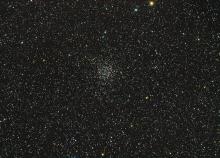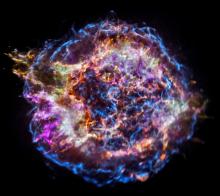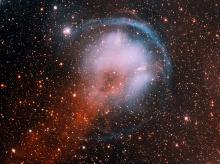Listen to today's episode of StarDate on the web the same day it airs in high-quality streaming audio without any extra ads or announcements. Choose a $8 one-month pass, or listen every day for a year for just $30.
You are here
Beta Cassiopeia
A bright star in Cassiopeia is in a short but impressive stage of life: It’s beginning to puff up like a giant balloon.
Beta Cassiopeia is in the north-northeast at nightfall. It’s at the top right point of the letter “W” formed by some of the constellation’s brighter stars.
Beta Cass is probably less than half the age of the Sun. But it’s almost twice as massive as the Sun, so it burns through its nuclear fuel much faster. In fact, it’s probably already consumed the original hydrogen in its core, converting it to helium. Gravity is causing the core to shrink and get hotter, which will allow it to start burning the helium to make even heavier elements.
In reaction to the changes in the core, Beta Cass’s outer layers are starting to puff up. Today, the star is roughly four times wider than the Sun. That’s big, but not nearly as big as the star will be. Over millions of years, it’ll puff up to dozens of times the Sun’s diameter. It’ll then shrink and cool a bit as it goes through another series of changes, before puffing up to even bigger proportions.
At the end of that second cycle, Beta Cass will expel its outer layers. That will briefly surround the star with a colorful bubble of gas and dust. The bubble will dissipate, though, leaving only the star’s now-dead core: a stellar corpse that will slowly cool and fade away into the long cosmic night.
Script by Damond Benningfield
Today's program was made possible by Mercer Caverns, in Calaveras County in California's historic Gold Country.






